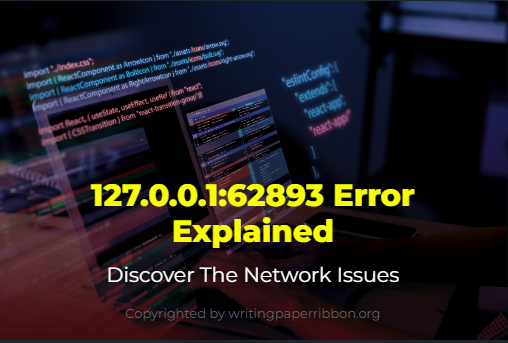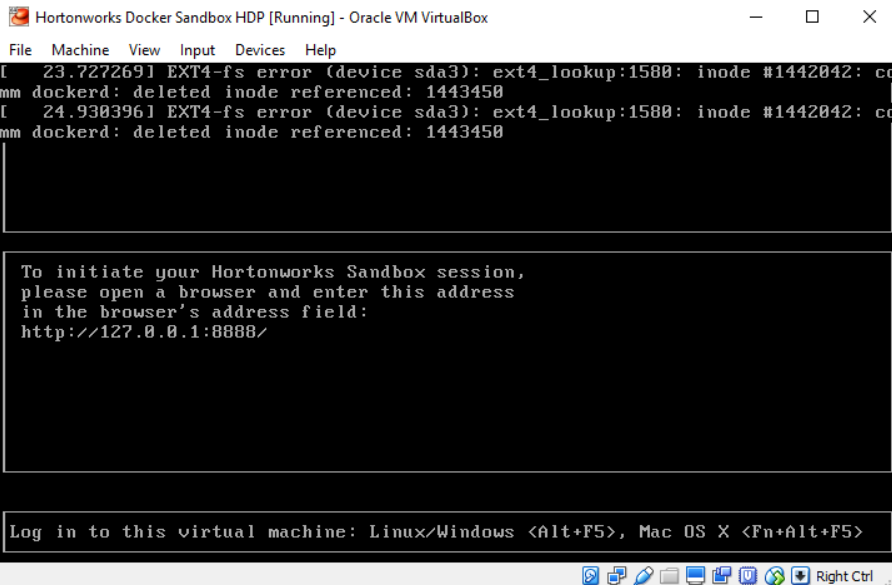127.0.0.1:62893 Error Explained: Discover The Network Issues
Introduction
Error 127.0.0.1:62893 is a network-related issue that can disrupt the functionality of applications relying on local host communication. This comprehensive guide delves into the causes, diagnosis, and resolution of this error, offering practical solutions and preventive measures.
Table of Contents
127.0.0.1 is the loopback address used to establish a connection to the same machine, essentially allowing a computer to communicate with itself. This address, also known as localhost, is fundamental in networking because it enables testing and troubleshooting of network software without the need for external network connections. By directing traffic back to the originating machine, 127.0.0.1 helps developers and network administrators simulate network communications and verify the functionality of network applications.
Significance of Port 62893

Ports are numerical identifiers used to distinguish between different services or applications running on the same machine. Port 62893 is one such specific port that can be assigned to a service or application for communication purposes. The combination of an IP address and a port number creates a unique endpoint known as a socket, which is essential for routing data to the correct application. When an error occurs with a specific port like 62893, it indicates a problem with the application or service trying to use that port, potentially disrupting communication and functionality.
Overview of the Error
Error 127.0.0.1:62893 occurs when there is a failure in establishing a connection through the specified port on the localhost. This can result from various issues, including configuration errors, network conflicts, or application-specific problems. Understanding the underlying causes of this error is crucial for diagnosing and resolving it effectively. Misconfigurations, software bugs, firewall settings, and network interface issues are common culprits, and each requires a specific approach to troubleshooting and resolution.
Common Causes of Error 127.0.0.1:62893
Misconfigured settings in applications or network services can prevent proper communication through port 62893. These configuration issues can arise from incorrect port assignments, typographical errors in configuration files, or improper application settings. For instance, if an application is mistakenly configured to use a port already in use by another service, it will be unable to establish the necessary connection, leading to errors. Ensuring that all settings are correct and consistent across applications is essential to prevent such conflicts.
Port Conflicts
Port conflicts occur when multiple applications attempt to use the same port, leading to connectivity issues. This is particularly common in development environments where multiple services may be running simultaneously. For example, if two web servers are configured to use port 62893, they will clash, preventing either from functioning correctly. Identifying and resolving these conflicts involves checking the port assignments for all running applications and ensuring that each service uses a unique port.
Firewall and Security Software
Firewalls or security software that block traffic on port 62893 can cause this error. Firewalls are designed to protect systems by controlling incoming and outgoing network traffic based on predetermined security rules. However, these rules can sometimes inadvertently block necessary communication, such as traffic to and from port 62893. Configuring the firewall to allow traffic on this port is crucial for resolving such errors. Additionally, security software like antivirus programs can interfere with network communications, and adjusting their settings might be necessary.
Network Interface Problems
Problems with the loopback network interface can disrupt localhost communication. The loopback interface is a virtual network interface used by the operating system to facilitate internal communication. If this interface is misconfigured or disabled, applications relying on localhost communication will fail. Ensuring that the loopback interface is properly configured and active is essential for maintaining reliable internal communication. This can involve checking network settings, verifying that the loopback interface is up, and troubleshooting any issues that arise.
Server Issues

Server-side problems, such as misconfigured services, software crashes, or server overload, can also result in errors when attempting to connect to localhost. For instance, if a service configured to listen on port 62893 crashes or is not properly started, attempts to connect to this port will fail. Monitoring server health and performance is crucial for identifying and resolving issues that can lead to errors like 127.0.0.1:62893. Ensuring that all services are running correctly and are properly configured helps maintain stable and reliable network communication.
Application-Specific Bugs
Bugs within the application attempting to use port 62893 can also cause this error. Software bugs can result from coding errors, incomplete features, or incompatibilities with the operating system or other software components. Debugging the application, reviewing logs, and applying updates or patches can help resolve these issues. Developers should follow best practices for testing and debugging to minimize the occurrence of application-specific bugs. Thorough testing, including unit tests and integration tests, helps identify and fix issues before they reach production environments.
Diagnosing Error 127.0.0.1:62893
When encountering error 127.0.0.1:62893, start by verifying the application settings to ensure it is correctly configured to use port 62893. This involves checking configuration files, ensuring that the correct port is specified, and verifying that no other applications are using the same port. Next, restart the application to rule out any temporary glitches. Sometimes, simply restarting the application or the system can resolve transient issues. Checking firewall settings is also crucial to ensure that port 62893 is not being blocked. These initial steps can help identify and resolve simple configuration issues quickly and efficiently.
Using Diagnostic Tools
Diagnostic tools play a vital role in troubleshooting network errors. Tools like Ping and Traceroute can verify that localhost is reachable and identify any routing issues. Network scanners, such as nmap, can help identify open ports and the services running on them. Application logs provide detailed information about the application’s behavior, including errors and warnings that can indicate the cause of the issue. Using these tools systematically can help pinpoint the source of error 127.0.0.1:62893. For example, Ping can confirm that the loopback address is reachable, while nmap can verify that port 62893 is open and being used by the intended service.
Identifying the Source of the Problem
By systematically checking configurations, firewall rules, and application settings, you can narrow down the source of the error. Identifying which application or service is attempting to use port 62893 is crucial. Tools like netstat or lsof can list the processes using specific ports, helping you determine the source of the conflict or misconfiguration. Understanding the application’s requirements and ensuring that no other services are interfering with port 62893 is essential for resolving the issue. Once the source is identified, you can take appropriate steps to adjust configurations, resolve conflicts, or address any bugs that might be causing the problem.
Fixing Error 127.0.0.1:62893

Restarting network services or the entire system can often resolve temporary issues causing the error. This action can clear out any stale configurations or stuck processes that might be interfering with network communication. Additionally, restarting the system ensures that all services and applications start fresh, potentially resolving conflicts and other transient issues. This simple step is often effective in resolving network errors quickly, especially in environments where multiple services and applications are running simultaneously.
Reconfiguring Network Settings
Ensure that network settings are correctly configured, including IP addresses, subnet masks, and gateway settings. Correct any misconfigurations that might be affecting localhost communication. For example, verify that the loopback interface is properly configured and active. Adjusting network settings to align with best practices can prevent errors related to misconfigurations. This includes ensuring that the correct IP address and subnet mask are used and that there are no conflicting settings that could disrupt communication on port 62893.
Adjusting Firewall and Security Settings
Modify firewall rules to allow traffic on port 62893. Ensure that security software is not blocking the necessary communication. This might involve adding exceptions for specific applications or ports in the firewall settings. Regularly reviewing and updating firewall rules helps maintain a balance between security and functionality. Ensuring that only necessary ports are open and that security policies are correctly configured prevents unnecessary blocks that can lead to errors.
Updating Software and Drivers
Update the application, operating system, and network drivers to ensure that there are no bugs or compatibility issues causing the error. Software updates often include bug fixes, performance improvements, and security patches that can resolve underlying issues. Keeping all components up to date is a proactive measure to prevent errors. Regularly checking for and applying updates ensures that systems are running the latest versions, reducing the likelihood of encountering known issues.
Contacting Support
If the error persists, contact the support team for the application or service. They can provide specific guidance and support for resolving the issue. Support teams have access to detailed technical documentation and can offer troubleshooting steps tailored to the specific application. Engaging with support ensures that you receive expert assistance in resolving complex issues. Additionally, support teams can escalate issues to developers if a bug or deeper problem is identified, facilitating a more comprehensive resolution.
Preventing Error 127.0.0.1:62893
Follow best practices for network configuration, including proper IP addressing, subnetting, and gateway settings. Consistent and well-documented network configurations help prevent errors caused by misconfigurations. Regular audits and reviews of network settings ensure that configurations remain optimal and up-to-date. Adhering to industry standards and guidelines for network configuration minimizes the risk of errors and enhances overall network reliability.
Regular Software Updates
Implement a regular update schedule for all software and drivers. Keeping applications and systems up to date ensures compatibility and addresses known bugs that could cause errors. Automated update systems can help streamline this process, ensuring that updates are applied consistently and promptly. Staying current with updates reduces the risk of encountering issues related to outdated software components.
Network Monitoring and Maintenance

Regularly monitor network traffic and perform maintenance to identify and resolve potential issues before they escalate. Network monitoring tools provide real-time insights into network performance, helping detect anomalies and potential problems early. Scheduled maintenance, including hardware checks and software updates, ensures that the network remains in optimal condition. Proactive monitoring and maintenance practices help prevent errors and ensure the network’s smooth operation.
Security Measures
Implement robust security measures, including properly configured firewalls, to protect against unauthorized access and conflicts. Ensuring that firewall rules are well-defined and regularly reviewed helps maintain network security without blocking necessary communication. Additionally, security policies should be regularly updated to address emerging threats and vulnerabilities. Balancing security with functionality is key to preventing errors like 127.0.0.1:62893 while maintaining a secure network environment.
Case Studies
Example 1: Software Conflict Resolution

A development team encountered error 127.0.0.1:62893 due to port conflicts between multiple applications. By reconfiguring the applications to use different ports, they were able to resolve the conflict and restore proper communication. This case highlights the importance of unique port assignments and thorough testing in development environments. Ensuring that each application has a dedicated port prevents conflicts and ensures reliable operation.
Example 2: Firewall Configuration Adjustment
A user experienced error 127.0.0.1:62893 because their firewall was blocking traffic on port 62893. By adjusting the firewall settings to allow traffic on this port, the user was able to resolve the error and restore functionality. This case demonstrates the impact of firewall configurations on network communication and the importance of correctly setting firewall rules to balance security and accessibility.
Example 3: Application-Specific Bug Fix
An application bug caused incorrect usage of port 62893, leading to error 127.0.0.1:62893. The development team identified the bug through detailed log analysis and debugging. They patched the application to correct the port assignment logic, resolving the error. This case underscores the importance of thorough testing and debugging in application development to identify and resolve issues that can disrupt network communication.
Advanced Troubleshooting
Analyzing network logs provides detailed insights into the communication patterns and potential issues causing the error. Logs can reveal failed connection attempts, misconfigurations, and other anomalies that may not be immediately apparent. By reviewing these logs systematically, administrators can identify patterns and pinpoint the root cause of the error. Detailed log analysis helps uncover underlying issues and informs the steps needed for resolution.
Analyzing Packet Captures
Using tools like Wireshark to analyze packet captures can help identify the specific traffic causing the error. Packet captures provide a granular view of network communication, showing the data being transmitted and any errors occurring during transmission. This level of detail can help diagnose issues related to packet loss, incorrect configurations, or protocol mismatches. Analyzing packet captures is a powerful technique for troubleshooting complex network errors and ensuring that communication flows as intended.
Collaborating with Network Engineers

Collaborating with network engineers can provide additional expertise and insights into diagnosing and resolving complex network issues. Network engineers have specialized knowledge in network infrastructure, protocols, and configurations that can be invaluable in troubleshooting. By working together, system administrators and network engineers can leverage their combined expertise to address challenging problems and implement effective solutions. Collaboration ensures that all aspects of the network are considered, leading to more comprehensive and lasting resolutions.
Advanced Tools and Techniques
Utilizing advanced tools and techniques, such as network simulators and debuggers, can aid in the thorough investigation and resolution of the error. Network simulators allow administrators to recreate network conditions and test various scenarios in a controlled environment. Debuggers provide detailed insights into application behavior, helping identify and fix bugs causing network errors. These advanced tools enhance the troubleshooting process, enabling more accurate diagnosis and effective resolution of complex issues.
Understanding Network Error Codes
Common network error codes include connection timeouts (408), forbidden access (403), and server errors (500). Each error code provides specific information about the nature of the issue, guiding administrators in their troubleshooting efforts. Understanding these codes and their meanings is essential for diagnosing and resolving network errors efficiently. For example, a 408 timeout error indicates that the server took too long to respond, while a 403 forbidden error means that access to the requested resource is denied.
Comparison with Error 127.0.0.1:62893
Unlike standard HTTP error codes, error 127.0.0.1:62893 is specific to localhost communication and requires a different troubleshooting approach. 127.0.0.1:62893 error is not related to external network traffic but to internal communication within the same machine. As such, resolving it involves focusing on local configurations, application settings, and network interfaces. Understanding the unique nature of this error helps guide the troubleshooting process and ensures that the appropriate steps are taken to resolve it.
Importance of Specific Error Codes in Troubleshooting
Specific error codes provide valuable information for diagnosing and resolving network issues efficiently. They help narrow down the potential causes and direct administrators to the most relevant areas for investigation. By understanding and interpreting error codes correctly, administrators can quickly identify the source of the problem and apply targeted solutions. This reduces downtime and ensures that network issues are resolved promptly, maintaining the reliability and performance of network services.
Role of System Administrators
System administrators are responsible for maintaining network stability and diagnosing issues when they arise. This involves monitoring network performance, configuring network devices, and troubleshooting errors like 127.0.0.1:62893. Administrators must be proactive in identifying potential issues, implementing preventive measures, and ensuring that network configurations are optimized. Their role is crucial in maintaining the smooth operation of network services and minimizing disruptions caused by errors.
Training and Resources
Ongoing training and access to resources, such as technical documentation and forums, are essential for system administrators to stay updated on best practices and troubleshooting techniques. Continuous learning ensures that administrators are equipped with the latest knowledge and tools to address emerging network challenges. Participation in professional development programs, certification courses, and industry conferences can enhance their skills and expertise. Staying informed about new technologies and trends in network management helps administrators maintain a high level of competence and effectiveness in their roles.
Collaboration with Development Teams
Collaboration between system administrators and development teams is crucial for addressing application-specific issues and ensuring network compatibility. Joint efforts can help identify and resolve issues that span both network and application layers. Regular communication and collaboration foster a better understanding of each team’s needs and challenges, leading to more effective problem-solving and smoother network operations. By working together, administrators and developers can ensure that applications are designed and configured to work seamlessly within the network environment.
Tools for Network Management

Network management tools include monitoring software, diagnostic utilities, and configuration management systems. These tools help identify, diagnose, and resolve network issues. Monitoring software provides real-time insights into network performance, alerting administrators to potential problems. Diagnostic utilities enable in-depth analysis of network traffic and configurations. Configuration management systems ensure that network devices are consistently and correctly configured. Together, these tools form a comprehensive suite for effective network management, helping administrators maintain optimal network performance and stability.
How These Tools Help Prevent and Resolve Errors
These tools provide real-time monitoring, automated alerts, and detailed diagnostics, enabling proactive management and quick resolution of network errors. For example, monitoring software can detect unusual traffic patterns and alert administrators to potential issues before they escalate. Diagnostic tools can identify the root cause of errors, while configuration management systems ensure that network settings are optimized and consistent. By leveraging these tools, administrators can detect and address issues early, preventing disruptions and maintaining network reliability.
Recommendations for Network Management Software
Popular network management tools include SolarWinds, Nagios, and PRTG Network Monitor. These tools offer comprehensive features for effective network management. SolarWinds provides a suite of tools for monitoring, diagnostics, and configuration management. Nagios offers extensive monitoring and alerting capabilities, while PRTG Network Monitor provides detailed insights into network performance and traffic. Choosing the right tools depends on the specific needs and requirements of the network environment. Evaluating the features, scalability, and support options of each tool helps ensure that the chosen solution aligns with the organization’s network management objectives.
Common Misconceptions
Some users may not fully understand the role of 127.0.0.1 and its importance in localhost communication, leading to incorrect troubleshooting steps. The loopback address is essential for testing and local communication, and its proper configuration is crucial for network stability. Educating users about its role and functionality can prevent misunderstandings and errors. Clear documentation and training on the use of localhost and loopback addresses help ensure that users and administrators understand their significance and how to configure them correctly.
Overlooking Simple Fixes
Users may overlook simple fixes, such as restarting the application or adjusting firewall settings, focusing instead on more complex solutions. Simple steps like restarting services or adjusting firewall rules can often resolve network errors quickly and efficiently. Emphasizing the importance of these basic troubleshooting steps can save time and effort. Providing clear guidelines and checklists for initial troubleshooting can help users and administrators quickly identify and resolve common issues without delving into more complex diagnostics prematurely.
Misconfiguring Firewall Settings
Incorrect firewall configurations can block necessary traffic, causing errors like 127.0.0.1:62893. Ensuring correct firewall settings is essential for preventing these errors. Regularly reviewing and updating firewall rules helps maintain a balance between security and functionality, preventing misconfigurations that can disrupt network communication. Educating users and administrators about the importance of correct firewall settings and providing clear instructions for configuring them helps prevent errors and ensures that necessary communication is not blocked.
Future Trends in Network Management

Automation and AI are becoming increasingly important in network management, helping to predict and resolve issues proactively. AI-powered tools can analyze network traffic patterns, detect anomalies, and provide recommendations for optimization. Automation enables the efficient management of routine tasks, freeing up administrators to focus on more complex issues. The integration of AI and automation into network management systems enhances their capabilities, enabling more proactive and intelligent management of network environments.
Enhanced Security Measures
Enhanced security measures, including advanced threat detection and response systems, are critical for protecting against increasingly sophisticated cyber threats. As network environments become more complex, robust security solutions are necessary to safeguard data and maintain operational integrity. Implementing advanced security measures, such as intrusion detection systems and automated threat response, helps protect networks from emerging threats. Staying updated with the latest security technologies and practices ensures that networks remain secure and resilient.
Improved Diagnostic Tools
Advancements in diagnostic tools will provide even deeper insights into network performance and issues, enabling more efficient troubleshooting and resolution. New diagnostic technologies offer greater visibility into network traffic, performance metrics, and potential bottlenecks. Improved tools for packet analysis, real-time monitoring, and anomaly detection help administrators quickly identify and resolve issues. Keeping abreast of these advancements ensures that administrators have access to the most effective tools for managing and troubleshooting network environments.
Conclusion
Understanding and resolving error 127.0.0.1:62893 involves a comprehensive approach to network configuration, diagnostics, and troubleshooting. By following best practices and using appropriate tools, you can maintain a stable and efficient network environment. Proactive management, regular updates, and collaboration between system administrators and development teams are key to preventing and resolving network errors. Staying informed about the latest trends and technologies in network management ensures that networks remain robust and resilient, capable of supporting the evolving needs of users and applications.
FAQs
What does error 127.0.0.1:62893 mean?
Error 127.0.0.1:62893 indicates a failure in establishing a connection through port 62893 on the localhost (127.0.0.1). This error commonly occurs when an application or service encounters difficulties in communicating with itself on the same machine.
How can I fix error 127.0.0.1:62893?
To fix 127.0.0.1:62893 error, you can try several troubleshooting steps:
- Restart the application: Sometimes, a simple restart can resolve temporary glitches.
- Check firewall settings: Ensure that your firewall is not blocking traffic on port 62893.
- Verify application configurations: Double-check the application settings to ensure that port 62893 is correctly specified and not being used by another application.
- Update software and drivers: Make sure that your application, operating system, and network drivers are up to date to address any compatibility issues or bugs.
- Contact support: If the error persists, reach out to the support team for the application or service for further assistance.
Why am I encountering error 127.0.0.1:62893?
There could be several reasons why you’re experiencing 127.0.0.1:62893 error, including:
- Configuration issues: Misconfigured settings in applications or network services.
- Port conflicts: Multiple applications attempting to use the same port.
- Firewall and security software: Blocking traffic on port 62893.
- Network interface problems: Issues with the loopback network interface.
- Server issues: Misconfigured services, crashes, or server overload.
- Application-specific bugs: Bugs within the application attempting to use port 62893.
Is error 127.0.0.1:62893 a common issue?
While it may not be as common as some other network errors, error 127.0.0.1:62893 can occur in various scenarios, particularly in development environments or when configuring network services. Port-related errors are not uncommon, and understanding how to troubleshoot and resolve them is essential for network administrators and developers.
How can I prevent error 127.0.0.1:62893 from occurring?
To prevent 127.0.0.1:62893 error, consider implementing the following preventive measures:
- Regularly update software: Ensure that all applications, operating systems, and network drivers are up to date.
- Check firewall settings: Review and adjust firewall rules to allow necessary traffic on port 62893.
- Follow best practices: Adhere to industry standards and guidelines for network configuration and application development.
- Monitor network traffic: Use network monitoring tools to detect anomalies and potential issues early.
- Collaborate with teams: Foster collaboration between system administrators and development teams to address application-specific issues and ensure network compatibility.
Is error 127.0.0.1:62893 exclusive to certain operating systems or applications?
No, error 127.0.0.1:62893 is not limited to specific operating systems or applications. It can occur across various platforms and software environments, especially those reliant on local network communication. Whether you’re using Windows, macOS, Linux, or any other operating system, encountering this error may require similar troubleshooting approaches and resolution strategies.
Can error 127.0.0.1:62893 pose security risks to my system?
While error 127.0.0.1:62893 itself is not a security threat, it could potentially expose vulnerabilities in your system if left unresolved. For instance, misconfigurations or software bugs leading to this error might indicate broader issues with network security or application integrity. Additionally, if the error prevents critical security-related applications or services from functioning correctly, it could indirectly compromise your system’s security posture. Therefore, it’s essential to promptly address and resolve error 127.0.0.1:62893 to mitigate any potential security risks.
Are there any specific diagnostic tools recommended for troubleshooting error 127.0.0.1:62893?
While various diagnostic tools can aid in troubleshooting error 127.0.0.1:62893, some commonly recommended ones include:
- Netstat: A command-line tool available on most operating systems that displays network connections, routing tables, and interface statistics. It can help identify processes using specific ports, including port 62893.
- Wireshark: A network protocol analyzer that captures and displays packet data in real-time. It allows for detailed analysis of network traffic, making it useful for diagnosing communication issues related to error 127.0.0.1:62893.
- Nmap: A network scanning tool used to discover hosts and services on a computer network. It can identify open ports and the services associated with them, aiding in port-related troubleshooting.
- TCPView: A Windows-based utility that provides a graphical interface for monitoring TCP and UDP activity on a system. It can help identify processes and applications utilizing specific ports, including port 62893.
What should I do if none of the troubleshooting steps resolve error 127.0.0.1:62893?
If you’ve exhausted all available troubleshooting steps and error 127.0.0.1:62893 persists, consider seeking assistance from experienced network administrators or consulting with the support teams of relevant software vendors. They may offer additional insights, specialized knowledge, or advanced troubleshooting techniques to help pinpoint and address the underlying cause of the error. In some cases, particularly with complex network configurations or application-specific issues, professional assistance may be necessary to achieve resolution.
If you found our content helpful don’t forget to share it on your social media: Twitter
More Articles: Home





6 Comments